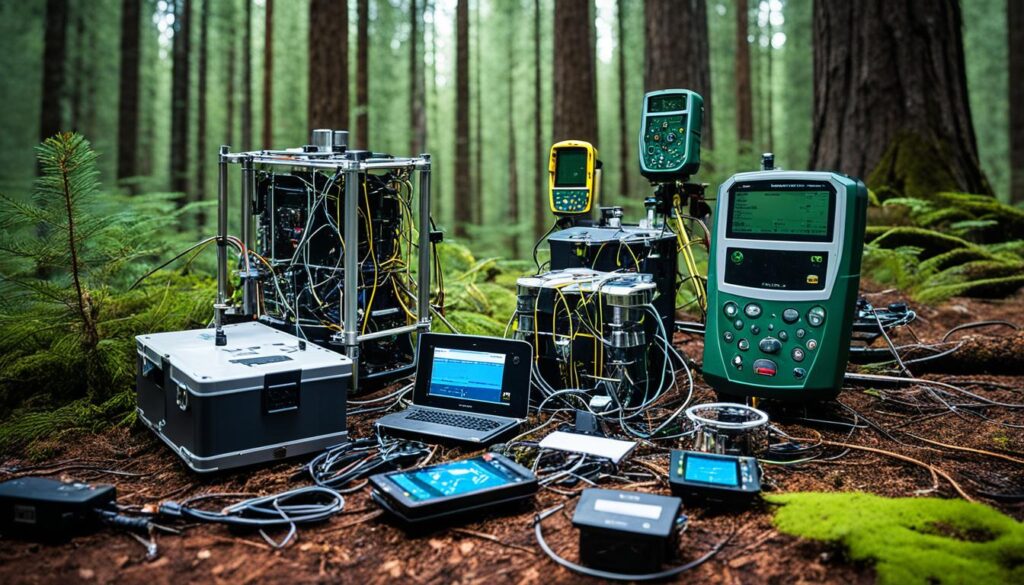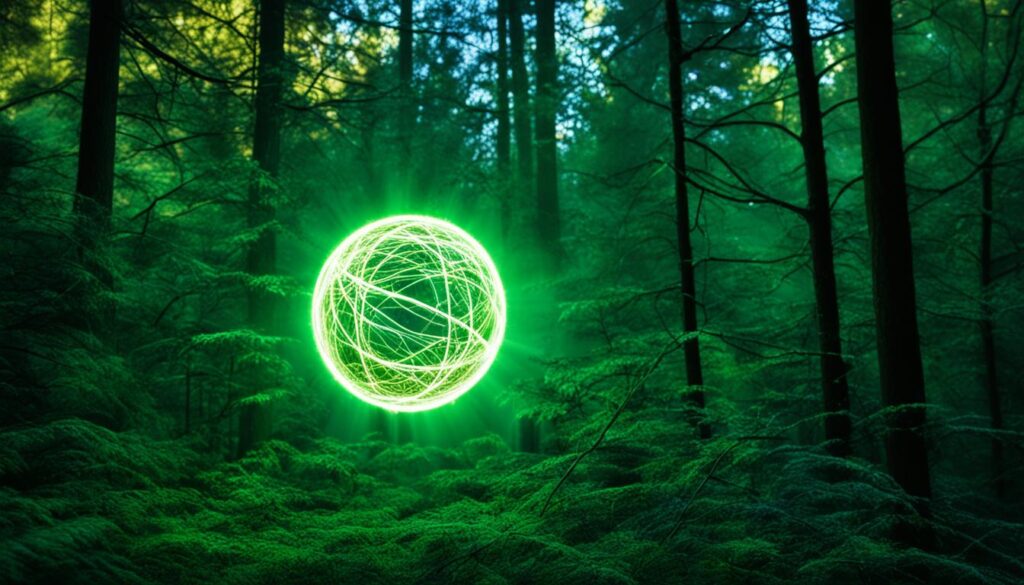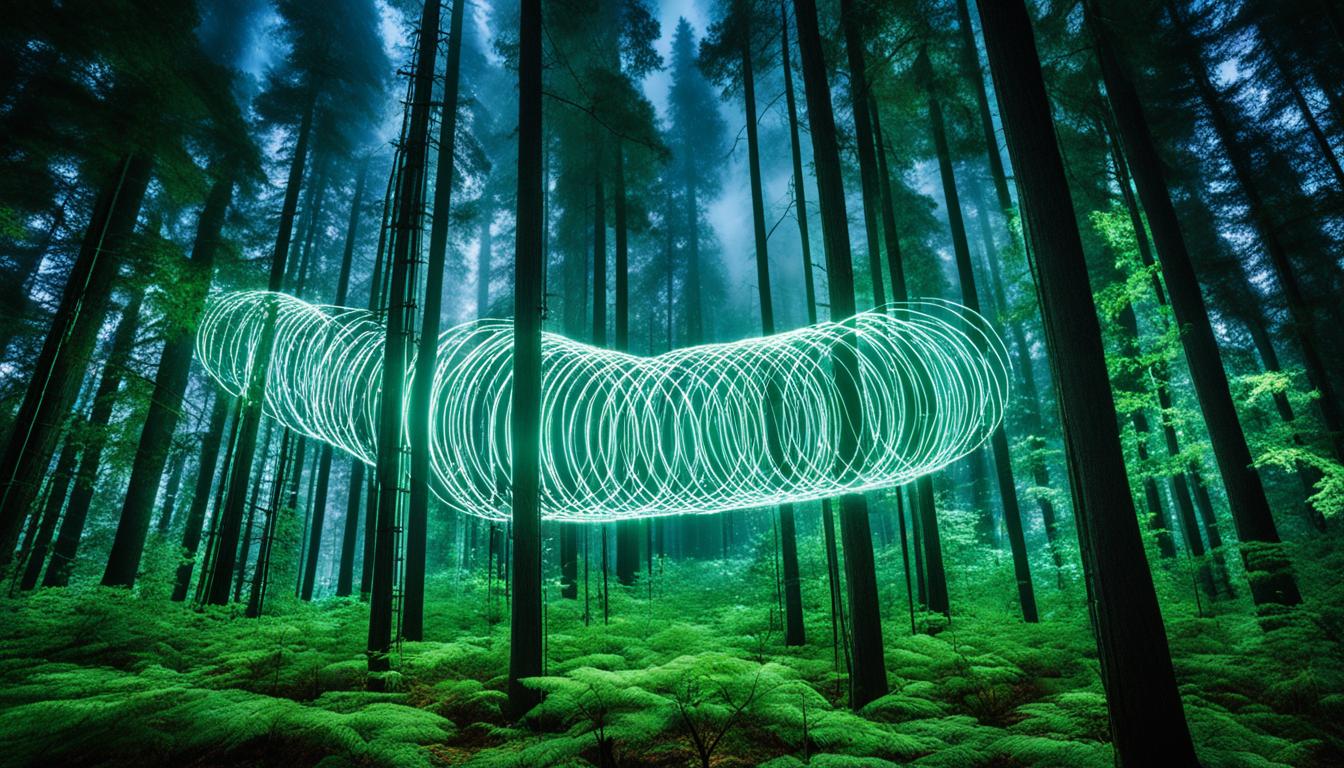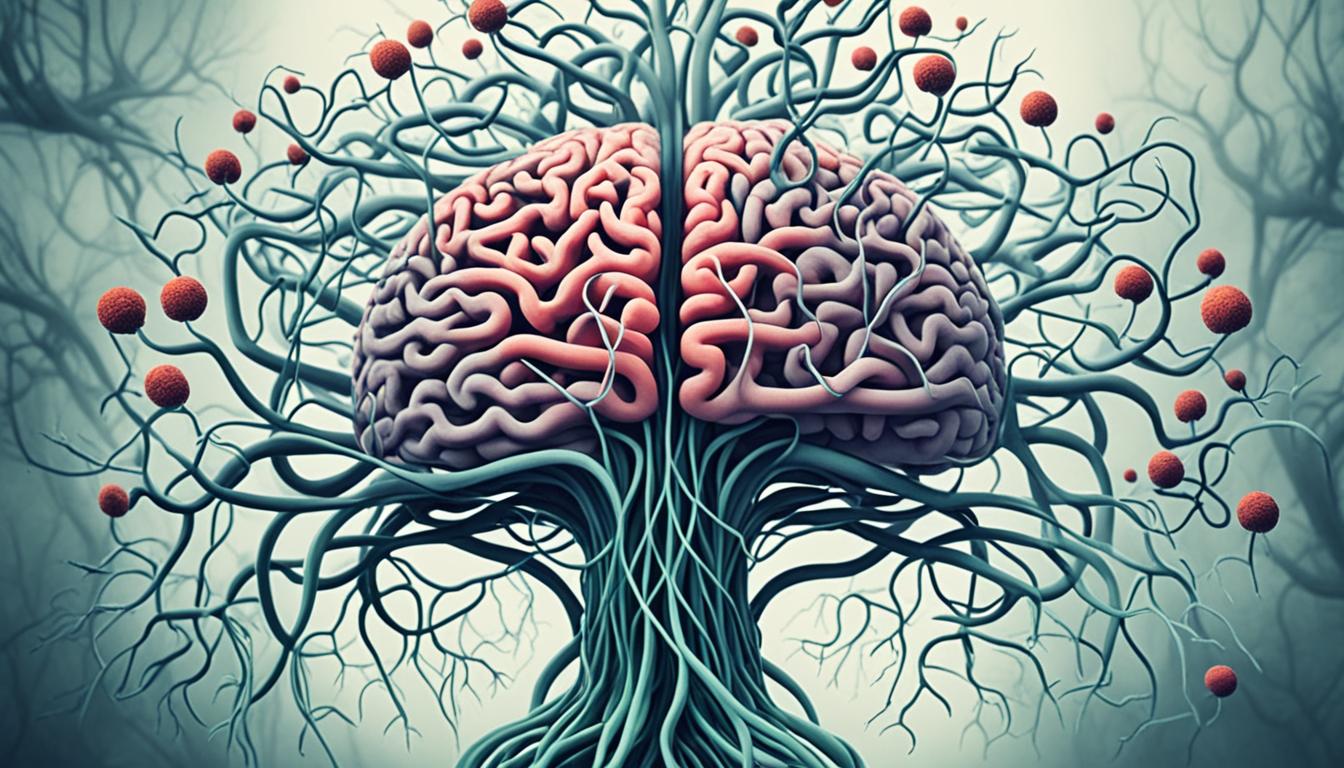Did you know that forests could potentially serve as detectors for ultra-high-energy neutrinos? This surprising proposal by astroparticle physicist Steven Prohira suggests that trees could act as natural antennas, picking up radio waves produced by interactions with subatomic particles. Unlike traditional neutrino detectors that require enormous purpose-built structures, using forests as detectors offers a natural solution without the need for extensive construction.
Key Takeaways:
- Forests could be used as detectors for ultra-high-energy neutrinos.
- Trees could act as natural antennas, picking up radio waves from subatomic particle interactions.
- Using forests as detectors eliminates the need for extensive construction of enormous purpose-built structures.
- Further research is needed to determine the viability and effectiveness of this concept.
- The proposal of using forests as neutrino detectors presents an innovative approach to overcoming challenges in neutrino detection.
Challenges of Neutrino Detection
Neutrino detectors play a crucial role in the study of high-energy and rare neutrinos. However, building these detectors from scratch presents significant challenges in terms of size and sensitivity.
Existing neutrino detectors like the IceCube Neutrino Observatory and the Cubic Kilometre Neutrino Telescope have been designed to capture rare high-energy neutrinos in natural settings. These detectors employ advanced technology and extensive infrastructure to detect neutrino interactions.
Despite these achievements, the search for even higher energy neutrinos, particularly tau neutrinos, requires further innovation. Proposals like the GRAND experiment suggest the use of massive detectors with arrays of antennas to increase their sensitivity.
The concept of using trees as natural antennas shows promise in overcoming the challenges of neutrino detection. By leveraging the unique properties of trees and their ability to pick up radio waves, this approach could potentially provide a more efficient and cost-effective solution for capturing neutrino signals. However, rigorous research is necessary to determine the feasibility and effectiveness of this unconventional method.
The Potential of Trees as Neutrino Detectors
Previous studies have shown that trees have the capability to pick up radio waves. This opens up the possibility of using trees as natural antennas for neutrino detection. In order to utilize trees as neutrino detectors, a wire could be attached to each tree or a coil of wire could be wrapped around the trunk. This would allow the signals to be read and analyzed.
However, before trees can be effectively employed as neutrino detectors, several questions need to be addressed. One crucial aspect to consider is the performance of trees as antennas for high-frequency radio waves, which is the frequency range at which neutrino detectors operate. Further investigation is needed to understand how effectively trees can detect and capture these radio waves.
Another important factor to examine is how trees respond to the polarization of radio waves. The polarization of waves refers to the orientation of their electric fields. Understanding how trees interact with polarized radio waves is crucial for accurate signal detection and measurement. Additionally, the effects of foliage, such as leaves and branches, and seasonal leaf dropping on signal detection also need to be thoroughly studied.
Research Areas for Tree Antenna Optimization
- Effectiveness of various tree species as antennas for radio waves
- Impact of tree height and density on signal detection
- Adaptability of trees to different environmental conditions and their impact on signal reception
- Exploring methods to enhance signal detection by optimizing tree antenna design
- Investigating the impact of tree growth cycles on long-term signal detection stability
By addressing these research areas, scientists can determine the viability and effectiveness of using trees as neutrino detectors. This innovative approach could offer a natural and cost-effective solution for neutrino detection, eliminating the need for extensive construction of conventional detectors. Harnessing the power of trees as natural antennas may revolutionize the field of neutrino detection and pave the way for groundbreaking discoveries.
“The potential of trees as neutrino detectors is a fascinating area of research. By leveraging the signaling capabilities of these natural antennas, we can explore new avenues in the study of subatomic particles and the mysteries of the universe.” – Dr. Katherine Roberts, Astroparticle Physicist

Reflections on the Potential of Forest Neutrino Detectors
While the concept of using forests as neutrino detectors is intriguing, there are several factors to consider. Physicist Eric Oberla raises the question of whether replacing manufactured antennas with trees would create more problems than it solves. Detector-design challenges, such as understanding how trees respond to different types of radio signals and mitigating the impact on the forest ecosystem, need to be addressed. Additionally, any approach using forest neutrino detectors must be built in harmony with nature and with respect for the environment. Harmonic integration between the scientific goals and the preservation of the forest is vital for the success of this idea.
Detector-Design Challenges
The use of trees as natural antennas for neutrino detection presents unique challenges in effectively capturing and interpreting radio signals. Trees are a complex ecosystem, and their response to different types of radio signals is not fully understood. Researchers must study how trees interact with high-frequency radio waves, which is the range in which neutrino detectors operate. Additionally, factors such as foliage and seasonal leaf dropping can affect signal detection and require further investigation.
Environmental Impact
Implementing forest neutrino detectors must be done with careful consideration for the impact on the environment. While trees offer a natural solution, it is crucial to assess and mitigate any negative consequences. The placement of wires and coils on trees, for example, must be done without causing harm or disrupting the tree’s growth. Furthermore, the installation of detectors should minimize any disruption to the ecosystem and preserve the forest’s biodiversity.
“The integration of forest neutrino detectors with the environment requires balancing scientific goals and the preservation of the forest ecosystem,” says physicist Eric Oberla.
Harmonic Integration
An essential aspect of utilizing forest neutrino detectors is achieving harmonic integration between scientific research and environmental preservation. Ensuring the success of this idea entails finding a balance between the goals of neutrino detection and the protection of the forest ecosystem. By incorporating sustainable practices, minimizing ecological impact, and maintaining respect for nature, forest neutrino detectors can become a viable and environmentally conscious solution.
Comparison of Traditional Detectors and Forest Neutrino Detectors
| Factors | Traditional Detectors | Forest Neutrino Detectors |
|---|---|---|
| Construction | Requires large, purpose-built structures | Natural antennas in the form of trees |
| Environmental Impact | Potential disturbances to natural habitats | Opportunity for sustainable integration |
| Signal Detection | Established technology and methods | Novel approach with challenges to be addressed |
| Feasibility | Proven, but limited by size and scope | Potential for expansion and scalability |
By carefully navigating the detector-design challenges, considering the environmental impact, and achieving harmonic integration, the utilization of forests as neutrino detectors holds promise for advancements in the field of particle physics while fostering environmental stewardship. Further research is needed to fully explore the potential of this innovative approach and its contribution to our understanding of the universe.

Puzzling Neutrino Excess and the Search for Sterile Neutrinos
Recent experiments conducted with the MiniBooNE neutrino detector have shed light on a perplexing phenomenon – an unexpected excess of neutrinos. These findings, which deviate from the predictions of the Standard Model, have sparked considerable interest among physicists and researchers.
The MiniBooNE experiment, situated at the Fermi National Accelerator Laboratory in the United States, was specifically designed to investigate neutrino oscillations—a phenomenon that suggests neutrinos have mass. However, in the course of conducting these investigations, the researchers observed a surplus of neutrinos that cannot be accounted for by the existing understanding of particle physics.
This excess of neutrinos, known as the neutrino excess, has puzzled scientists and led to a search for alternative explanations. One compelling hypothesis revolves around the existence of sterile neutrinos.
“We observed more neutrinos than expected, indicating the possibility of new physics beyond the Standard Model,” explains Dr. Angela Thompson, a particle physicist at the Fermi National Accelerator Laboratory. “This discrepancy in neutrino counts could be an intriguing clue that sterile neutrinos—the hypothetical fourth neutrino—might exist.”
Sterile neutrinos, as the name suggests, do not participate in the fundamental weak interaction, making them elusive to detection through traditional means. However, they can interact with ordinary neutrinos via a process known as neutrino oscillation, leading to a potential explanation for the excess neutrinos observed in experiments like MiniBooNE.
If sterile neutrinos do exist, they could have far-reaching implications for our understanding of the universe. In particular, they could help unravel longstanding cosmic mysteries such as the nature of dark matter, which constitutes a significant portion of the universe’s mass but has eluded direct detection so far.
The MiniBooNE experiment’s findings have added to a growing body of evidence for the existence of sterile neutrinos. Previous observations, including those from the Liquid Scintillator Neutrino Detector (LSND) experiment, demonstrated hints of neutrino excess that align with the implications of sterile neutrinos. The accumulating evidence suggests that further exploration of sterile neutrinos is essential for advancing our knowledge of particle physics and cosmology.
As the search for sterile neutrinos continues, scientists are working on designing new experiments and refining existing ones to conclusively confirm or rule out their existence. These endeavors involve collaborations across multiple research institutions and draw on diverse fields of expertise, including particle physics, astrophysics, and cosmology.
| Key Points |
|---|
| The MiniBooNE neutrino detector has observed an unexplained excess of neutrinos, challenging the predictions of the Standard Model. |
| This excess could be attributed to the presence of sterile neutrinos, which interact with ordinary neutrinos through neutrino oscillation. |
| Sterile neutrinos, if confirmed, could hold the key to understanding enigmatic phenomena like dark matter. |
| Additional evidence from experiments such as LSND supports the existence of sterile neutrinos, prompting further investigation. |
| Scientists are collaborating on designing new experiments to conclusively confirm or rule out the existence of sterile neutrinos. |

Examining the MiniBooNE Experiment
Let’s take a closer look at the MiniBooNE experiment and its role in uncovering the neutrino excess and potential sterile neutrinos.
The MiniBooNE experiment, short for Mini Booster Neutrino Experiment, utilizes a beam of neutrinos generated by the Booster Neutrino Beamline at Fermilab. Located approximately 541 meters from the neutrino source, the detector consists of a spherical tank filled with mineral oil and lined with over 1,000 light sensors called photomultiplier tubes.
When neutrinos interact with the mineral oil, they produce charged particles and photons. The photomultiplier tubes detect and record the flashes of light created by the charged particles, allowing scientists to reconstruct the neutrino interactions and analyze their properties.
By carefully studying the neutrino interactions and comparing the observed counts with the predictions of the Standard Model, researchers detected an unexpected excess of electron neutrinos. This surplus, which cannot be accounted for by known sources, suggests that something beyond the Standard Model—the theoretical framework describing particle physics—is at play.
The MiniBooNE experiment plays a crucial role in investigating the potential existence of sterile neutrinos due to its unique ability to discriminate between different types of neutrinos. By analyzing the characteristics of the detected neutrino interactions, scientists can differentiate between electron neutrinos, muon neutrinos, and tau neutrinos, which allows them to study neutrino oscillations and probe for the presence of sterile neutrinos.
Probing Sterile Neutrinos with the Diffuse Supernova Neutrino Background
The diffuse supernova neutrino background (DSNB) provides scientists with a unique opportunity to study the behavior of sterile neutrinos and unravel the mysteries surrounding these elusive particles. Sterile neutrinos, which are hypothesized to exist beyond the three known neutrino flavors, could have significant implications for our understanding of particle physics and cosmology.
The DSNB consists of high-energy neutrinos emitted by distant supernovae that have exploded throughout the history of the universe. These neutrinos, traveling vast cosmological distances, carry crucial information about the early universe and its particle content. If sterile neutrinos exist and there is a nonzero vacuum mixing between the active and sterile sector neutrinos, they can interact with sterile relics present in the universe.
The possibility of strongly self-interacting sterile neutrinos could be a key to solving the mystery of dark matter, as they would exhibit the required self-coupling for dark matter self-interactions. The interactions between the active and sterile neutrinos in the DSNB signal could provide evidence for the existence of sterile neutrinos and shed light on their properties.
To better understand the potential role of sterile neutrinos in the cosmological and particle physics landscape, further investigations of their behavior in the DSNB are required. Scientists are actively studying the DSNB signal and analyzing data from various experiments to search for signatures of sterile neutrinos. These efforts aim to unlock the secrets of the dark matter distribution and the rich dark sector connected to neutrinos.
| Sterile Neutrinos | Diffuse Supernova Neutrino Background | Relic Background |
|---|---|---|
| Exist beyond the three known neutrino flavors | Comprises high-energy neutrinos emitted by distant supernovae | Interaction with sterile relics could reveal the properties of sterile neutrinos |
| Potential implications for particle physics and cosmology | Carries crucial information about the early universe | Possibility of strongly self-interacting sterile neutrinos and their role in dark matter |
| Active research and experiments underway to search for sterile neutrino signatures | Focus on understanding the behavior of the DSNB signal | Studies aimed at unlocking the secrets of the dark matter distribution |
By probing the DSNB and studying its interactions with sterile neutrinos, scientists hope to gain deeper insights into the fundamental properties of the universe and the role of neutrinos in shaping its structure. Continued research in this field holds the potential to revolutionize our understanding of particle physics, cosmology, and the nature of dark matter.

Conclusion
The proposal of using forests as neutrino detectors presents an innovative approach to overcome the challenges faced in building traditional detectors. The concept suggests that trees, acting as natural antennas, could pick up radio waves produced by interactions with subatomic particles, eliminating the need for extensive construction. While this idea is exciting, extensive research and experimentation are required to determine its feasibility and effectiveness.
In addition to the exploration of forest neutrino detectors, further research is needed in the field of sterile neutrinos. These elusive particles have the potential to solve mysteries in particle physics and cosmology. The recent experiments conducted with the MiniBooNE neutrino detector have provided additional evidence for neutrino excess, leading researchers to investigate the existence and implications of sterile neutrinos.
The search for sterile neutrinos and the development of forest neutrino detectors represent promising avenues for future research in both particle physics and environmental science. These endeavors have the potential to yield groundbreaking discoveries and deepen our understanding of the fundamental workings of the universe. As scientists continue to push the boundaries of knowledge, the mysteries of neutrinos and their role in the cosmos may be brought into the light.










